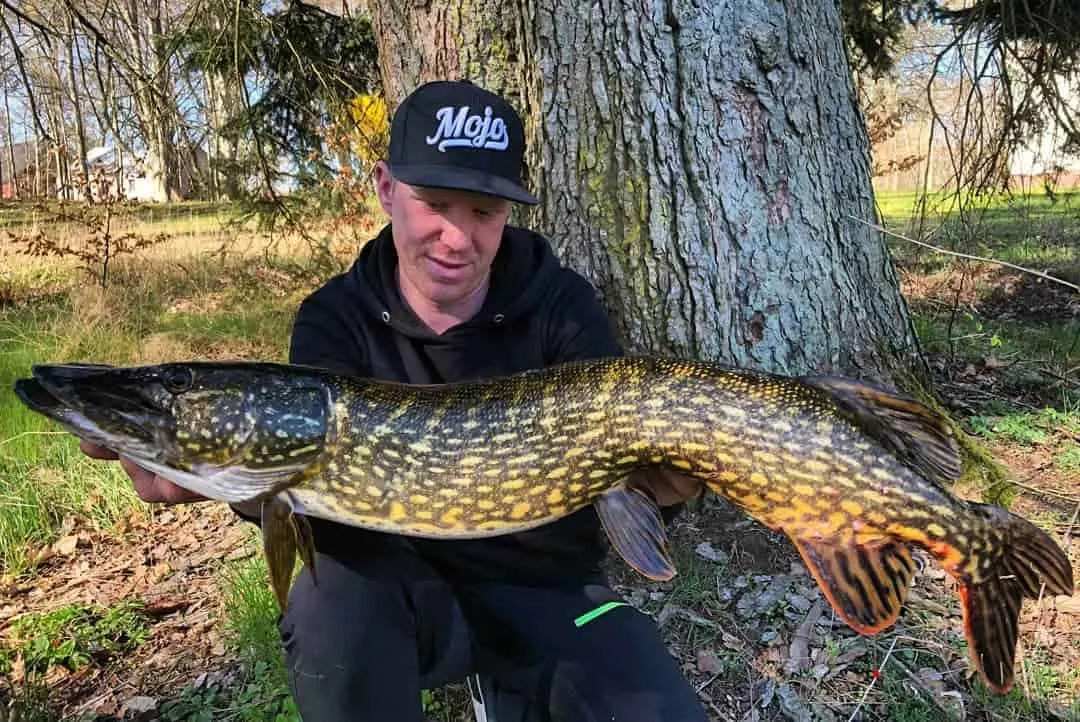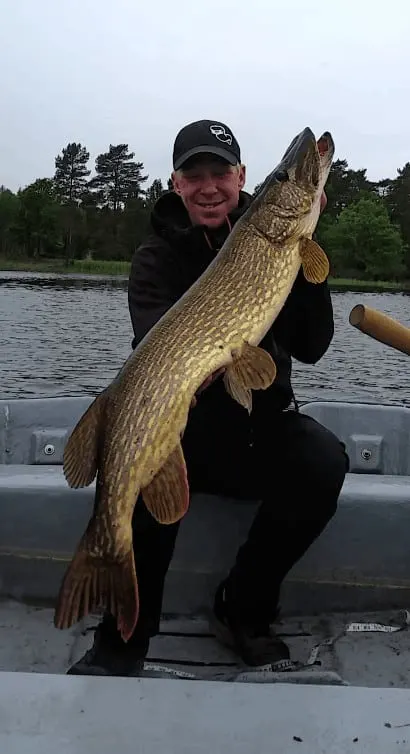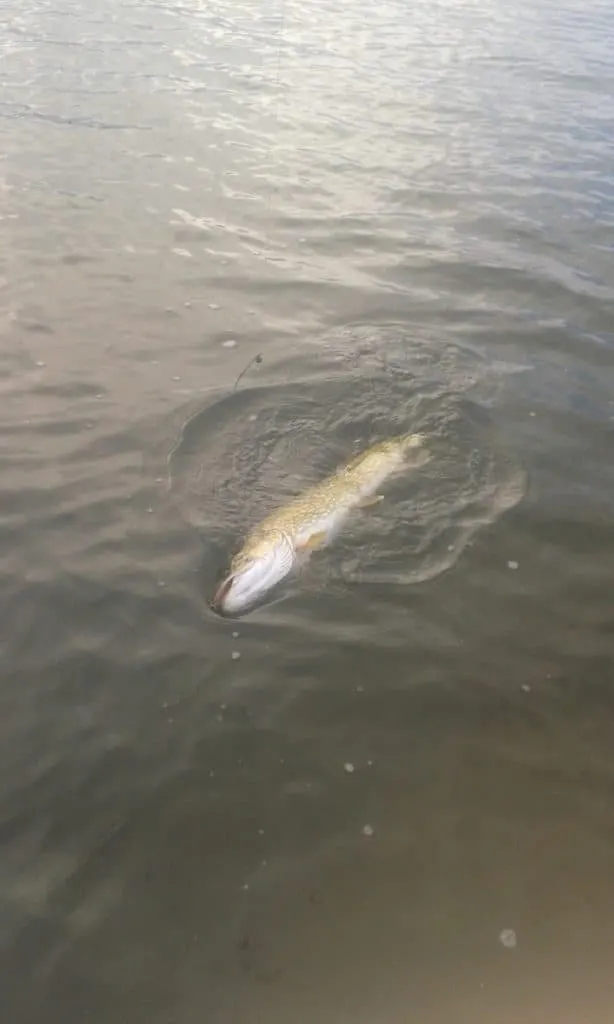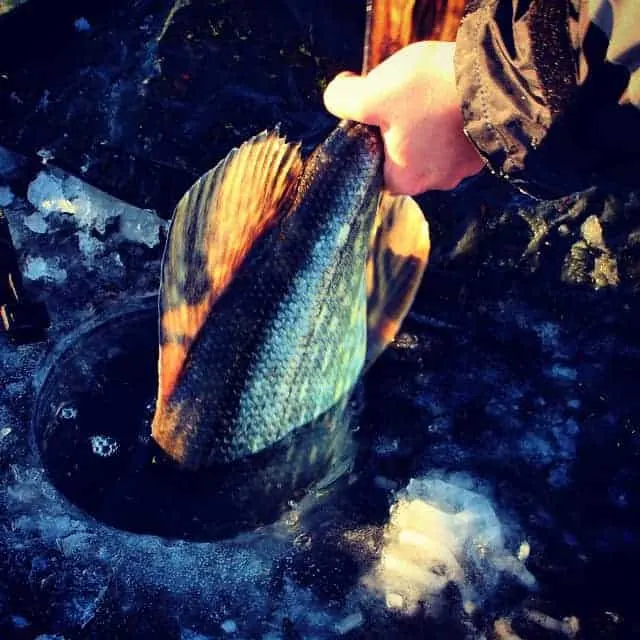Pike can be found all over the Northern hemisphere, but only in a few places can you actually fish for pike in salty water. I happen to live in one of them and decided to write an extensive article on the topic of saltwater pike fishing.
If you are planning to fish for pike in saltwater, this guide will help you catch them in no time.
PRO TIP: Need to gear up for your next pike adventure? Then check out this quality equipment on Amazon.
It’s very cost-effective, durable, and will land you plenty of trophy pike!
Where Can You Fish for Saltwater Pike?

If you want to fish for saltwater pike, you will have to travel to Northern Europe, which’s the only region in the world where this type of fishing is possible. More specifically, you would have to fish the Baltic Sea’s coastal waters in either Southern Denmark, Northern Germany, or Sweden.
Germany
Only the Baltic Sea’s coastal areas of Northern Germany allow for saltwater pike fishing. Here, you will find huge straits and bay areas, where plenty of pike reside. One of which is a gigantic strait called Strelasund, which separates the island of Rügen from the German mainland.
Another one is the Rügen Bodden, which is a series of large bays surrounding the island of Rügen.
Both of these locations are found near the German cities of Stralsund and Greifswald, close to the Polish border. It is here you want to travel if you are after exclusive saltwater pike fishing!
These areas are extremely fish-rich and rather brackish, allowing for the pike to grow extremely fast and very big. Without exaggerating, I can actually call these German pike waters one of the best, if not the best, in the world! It’s definitely worth a visit and you could most certainly end up catching the pike of your life.
Sweden
If you want to fish saltwater pike in Sweden, you should head eastward! The regions Blekinge and Småland/Kalmar, in the Southeast of Sweden, are known for their world-class Baltic Sea pike fishing.
Blekinge’s archipelago stretches over more than 500.000 acres and holds plenty of big pike. Every year, fish way over 25 lb get caught here during spring and fall.
The Kalmar Strait, which separates the island of Öland from the Swedish mainland, is around 130 km long and between 5 and 25 km in width. Think of it as a very long brackish lake full of pike. Fish between 15 and 20 lb are quite common here and 30 plus pounders are a good possibility if you fish the right spot at the right time.
If you ever happen to be in the area, make sure to send me an email, as I live very close to the Kalmar Strait here in Sweden. I would be happy to guide you to some awesome saltwater pike!
Going further up north, practically the entire east coast of Sweden is equal to decent pike fishing and well worth a fishing holiday, for both its exquisite fishing and nature.
Denmark
If you want to find saltwater pike in Denmark, you will have to head to the Southeastern parts of that little country. Basically, all the coastal regions around the islands Falster and Lolland are suitable for pike fishing.
A special tip is the Guldborg Strait, which runs between the islands Falster and Lalland. Here, some of Denmark’s biggest pike get caught year after year. This entire area is, by the way, located very close to the German pike waters of Rügen.
Why Are There Pike in These Saltwater Areas?
So, how is it even possible for pike to live in these saltwater areas of Northern Europe? Well, pike can live in these waters for two main reasons:
- The Baltic Sea’s lake-like nature means both a lot of pike-suitable, shallow coastal areas and a year-round moderate water temperature.
- The Baltic Sea is also the world’s largest body of brackish water, due to the fact that it is almost tightly surrounded by land, almost entirely. Additionally, numerous rivers provide the Baltic Sea with plenty of freshwater, which is why the pike, and many other freshwater species, prefer its coastal areas. This is especially obvious in Sweden, where pike fishing in and around river mouths can be dreamlike.
RELATED ARTICLE: Find out more about the apex predator that is the northern pike by also reading this article!
Where to Locate Pike in Saltwater?

Now that you know where to find saltwater pike fishing regions, let’s move on to the actual locations and hot spots! Remember that large bays, archipelagos, straits, and shallower areas off islands and the number one spots for saltwater pikes.
Depths
Generally, you should stay close to the shore. The open sea is not the place to fish for saltwater pike! If and when you have decided on an area you want to fish, preferably by boat, start very close to land and fish your way into deeper waters.
Anything from very shallow (less than 1 meter/3 foot) to depths of 6 to 8 meters/18-25 feet can hold pike in the Baltic Sea. Deeper than that is possible, but then you really have to have a fish finder or a guide with you, in order to find the baitfish swarms out there in the deeper waters.
Reeds
The easiest and safest way to start is to find reeds or any other vegetation. Much like in a lake, reeds provide shelter and a lot of food, and even saltwater pike are drawn to it.
You can find reeds all over the place in those larger bay areas and those belts can sometimes stretch over several kilometers!
That means plenty of spots to try out. When fishing near reeds, it is crucial that you fish both the edge of a reed belt and the area outside of it.
Most likely, pike will be all over the place and if they aren’t in the reeds, they can actually be quite some distance away from it. Try to cover the entire area surrounding these reed belts!
Reefs
Especially in more open waters a little further off the shore, finding reefs can be a key factor when it comes to a successful saltwater pike fishing trip.
Reef features provide shelter in an otherwise totally open and vulnerable environment and a lot of fish are drawn to such underwater havens. Once again, you will probably need the help of either a fish finder or a local guide.
Once you have found a reef, try to fish all around it and at different depths. Chances are good that you will get a few takes, as there are usually small packs of pike around such features, especially, if there is a lot of prey around, which is usually the case here!
Drop-Offs
If you can locate steep drops, you will find the pike. These areas can offer spectacular fishing opportunities and sudden drops or verges in saltwater are no exception to that rule.
If you find sudden drops of a few meters/5 to 10 feet, you should most certainly fish them extensively. Make sure you fish both the upper and lower end of these drops, as pike can be found at any given depths around a steep drop.
Personally, though, I have found that more pike can usually be found close to the bottom of these drops.
Rocks
In shallower areas close to the shore, you should fish spots that have a lot of rocks in them. Here, we are talking big rocks that can provide a hiding spot for a pike, behind which it can suddenly launch from.
This type of saltwater fishing for pike is fairly similar to brown trout fishing.
These two species often share the same hunting grounds in shallow saltwater areas, which is why you should never disregard fishing both very close to shore and in very shallow depths.
RELATED ARTICLE: Want tips on how to catch pike in any water? Then make sure aslo to check out this helpful article!
Best Seasons to Fish for Saltwater Pike

Spring and Fall definitely stand out when it comes to the best seasons to fish for saltwater pike in the Baltic Sea. Depending on the country and area you are fishing in, different “closed seasons” and periods when you aren’t allowed to fish will apply during spring when the pike are spawning.
Generally, though, most waters will allow fishing throughout the entire spring season, including pre and post-pike spawning periods.
In the fall, as soon as the air and water temperatures start to drop, the hunt for saltwater pike is on again.
Generally, fishing starts in September and gets better and better the more the year progresses towards its end. Fishing in November can be absolutely phenomenal in the Baltic Sea.
Another advantage of these two seasons is that the vegetation and algae are practically nonexistent in the Baltic Sea. These can otherwise cause serious problems during a fishing trip.
Insider tip: If at all possible, fish in murky water, as saltwater pike will spook fairly easy in clear water!
Spring
If you are after the fat pre-spawning pike of late winter and early spring, fishing in February and March (where allowed) is just the right time for you.
Of course, locating the fish and getting bites will be somewhat more of a challenge now, as the pike are not as active and hungry in the still cold waters of this month.
Nonetheless, with the right weather conditions, you can get them going regardless of the current water temperature and the chance of catching that big mummy are really the best ones you’re gonna get!
Fishing in may (where allowed) will make catching the now post-spawn pike much easier. The fish are super hungry, super active and the water temperature is now suddenly very favorable.
RELATED ARTICLE: What Is the Best Time of Day to Catch Pike?
Fall
When summer has come to an end and the water temperature slowly starts to drop, it’s time to catch big saltwater pike again!
Saltwater pike fishing starts to get going in September and then peaks in October and November. These two last months are definitely two of the very best pike months of the entire year.
This has to do with both the water temperature and the upcoming winter season. Lower temperatures mean more oxygen in the Baltic Sea and hence, more fish activity.
It is now that all species will have to feed and build up their winter fat. In late fall, you can often see enormous swarms of baitfish swimming around in the larger bay areas or just outside of those.
Spotting them with a fish finder is an easy task now, and if you’re really lucky, you can even see them “live” in a shallower bay, if the water is clear enough.
But either way, if you have found those swarms, you will most certainly hit pike bull’s eye that day!
If you want to read up on how to fish for northern pike in the fall, check out this related article I wrote: What Is The Best Time of Year to Catch Northern Pike?
Best Lures for Saltwater Pike Fishing
If you want to spin fish for saltwater pike, there is a wide range of lures that you can use, in order to catch big fish. These are the most common ones that fishermen use in the Baltic Sea:
- Jerkbaits
- Crankbaits
- Spinnerbaits and large spinners
- Softbaits
Personally, I very much prefer soft lures when spin fishing for pike in salty water. The fact that you can twitch soft lures extremely slowly over the bottom makes this lure very attractive when fishing in cold spring and fall water.
Common jigs of 10-15cm/4-6 inches will do the job just fine. If there is some vegetation present, or you want to present your soft lure directly outside a reed belt, you can instead drop shot your soft lure and remain in one place for a longer time, just twitching it slightly though and then.
Best Lure Colors for Saltwater Pike
This is a tricky one because virtually all lure colors have produced saltwater pike! Nevertheless, there are those colors that just stick out a little more than the rest and produce pike even when the fishing is slow.
You should definitely match the hatch when it comes to choosing lure colors. A lot of pike prey in the Baltic Sea is made up of herring, roach, and bleak.
And what do these fish all have in common? Exactly, they are all blueish and silvery, with a hint of green in them.
So, if you are choosing any of these three colors, or a combination of them, your lure, be it a jig, spinnerbait, or jerk bait will most definitely look like the local pike food!
I have also found that such colors work in both murky and clear water! I guess the pike are simply used to those and hence, they have more confidence in devouring them.
But once again, all kinds of colors and lures certainly can produce pike, so don’t focus on only the one best bet.
Take a handful of trusted lures and colors with you and get them wet, in order to see what works on that day and what doesn’t.
Float Fishing With Baitfish for Saltwater Pike

Fishing with live and dead bait on the float is also an extremely popular method of catching saltwater pike. On many days, I have found that a slowly wondering baitfish on the float, or bobber, will produce much more pike than a lure would.
Once again, that has probably to do with the cold water and the correlating lower activity of the fish. A baitfish that will remain in the same area for a long period of time can eventually trigger the pike to bite.
On the other hand, a lure would just pass by that inactive fish a couple of times, and then the angler either casts somewhere else or simply leaves the spot for another.
So, if you have some extra patience, remaining in one spot, fishing with a float and a baitfish, can often bring you those extra bites.
Bait-wise, you should once again match the hatch as much as you possibly can. Bleak are not recommended, as they are rather small and can die off quickly on the hook.
Decently sized roach (8-18cm/3-6 inches) are probably your best choice for live bait! For deadbait, herring is a wonderful choice, but even mackerel (or half of one) can produce a lot of fish.
RELATED ARTICLE: What Is the Biggest Pike Ever Caught?
Can You Ice Fish for Saltwater Pike?

You most certainly can, if there actually is thick enough ice on the Baltic Sea. Due to its low salinity, it does freeze over fairly quickly and during a good, cold winter, the ice can certainly get thick enough to be safe.
During the last decade, however, cold winters have become a rarity in this part of the world.
In fact, during the last couple of winters, there was barely any snow or ice! On the other hand, this allows us anglers to fish for pike in open water even during the cold season, which certainly has its charm.
But if you are in the region and there is enough ice, you should try out ice fishing for saltwater pike, for sure! It can be a lot of fun and the fishing can actually be very productive if the weather conditions are right and there is a little milder air present.
Essential Gear Tips
If you’re looking for solid and reliable pike fishing equipment, these tips might be useful for you.
The following tackle is of top quality and sells at a very reasonable price on Amazon:
Rod: 7′ MH St. Croix Premier Casting Rod
A versatile and beautifully made medium-heavy 7′ baitcasting rod that’s perfect for bigger predators. Casts anything up to 2.5 ounces extremely well. Has an awesome balance, action, and sensitivity.
Reel: Abu Garcia Revo Beast 41 Baitcasting Reel
An affordable, high-performance baitcasting reel with amazing strength. Casts super smoothly and will last you forever! Makes for a great pike combo together with the Ugly Stick!
Mainline: Power Pro Spectra
One of the best braids available today. Zero stretch, great feel, and immense strength make this line the perfect pick for pike in both open and snaggy waters. Put on a 30lb test and you’re good to go.
Related Pike Articles
If you want to learn more about the northern pike, you should also check out these articles:
- How to Catch Pike in Cold Water (Best Strategies)
- How to Best Ice Fish for Northern Pike?
- Can You Catch Pike at Night?
All images courtesy of Peter Woksepp

